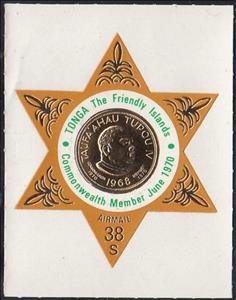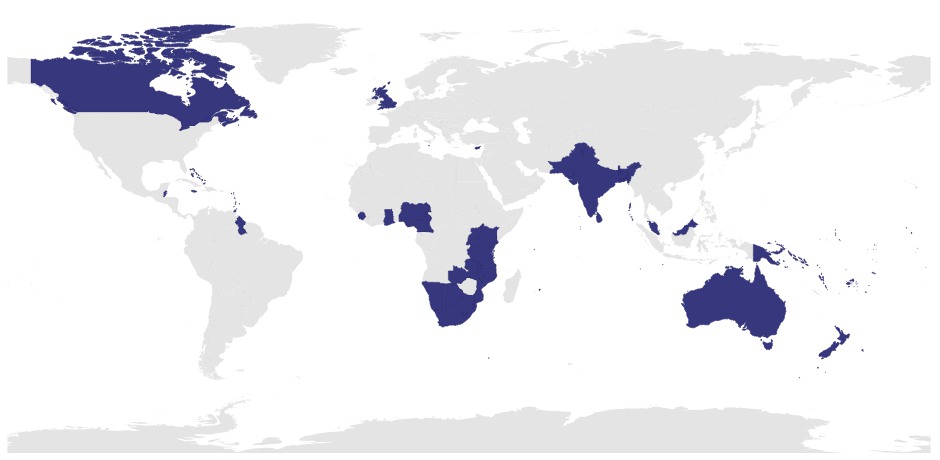Stamp: King Tāufaʻāhau Tupou IV (1918-2006) (Tonga 1970)
King Tāufaʻāhau Tupou IV (1918-2006) (Tonga 1970)
04 June (Tonga ) within release Entry into British Commonwealth goes into circulation Stamp King Tāufaʻāhau Tupou IV (1918-2006) face value 38 Tongan seniti
| Stamp King Tāufaʻāhau Tupou IV (1918-2006) in catalogues | |
|---|---|
| Michel: | Mi: TO 323 |
| Stamp Number: | Sn: TO C77 |
| Stanley Gibbons: | Sg: TO 324 |
Stamp is square format.
Also in the issue Entry into British Commonwealth:
- Stamp - King Tupou IV face value 10;
- Stamp - Book, Tongan monarchs and flag face value 3;
- Stamp - Book, Tongan monarchs and flag face value 15;
- Stamp - Book, Tongan monarchs and flag face value 25;
- Stamp - Book, Tongan monarchs and flag face value 50;
- Stamp - King Tāufaʻāhau Tupou IV (1918-2006) face value 9;
- Stamp - King Tāufaʻāhau Tupou IV (1918-2006) face value 24;
- Stamp - King Tāufaʻāhau Tupou IV (1918-2006) face value 29;
- Stamp - King Tāufaʻāhau Tupou IV (1918-2006) face value 38;
Stamp King Tāufaʻāhau Tupou IV (1918-2006) it reflects the thematic directions:
Famous People refers to the fame and public attention accorded by the mass media to individuals or groups or, occasionally, animals, but is usually applied to the persons or groups of people (celebrity couples, families, etc.) themselves who receive such a status of fame and attention. Celebrity status is often associated with wealth (commonly referred to as fame and fortune), while fame often provides opportunities to make money.
A head of state (or chief of state) is the public persona that officially represents the national unity and legitimacy of a sovereign state. In some countries, the head of state is a ceremonial figurehead with limited or no executive power, while in others, the head of state is also the head of government. In countries with parliamentary governments, the head of state is typically a ceremonial figurehead that does not actually guide day-to-day government activities and may not be empowered to exercise any kind of secular political authority (e.g., Queen Elizabeth II as Head of the Commonwealth). In countries where the head of state is also the head of government, the president serves as both a public figurehead and the actual highest ranking political leader who oversees the executive branch (e.g., the President of the United States).
King is the title given to a male monarch in a variety of contexts. The female equivalent is queen regnant (while the title of queen on its own usually refers to the consort of a king). In the context of prehistory, antiquity and contemporary indigenous peoples, the title may refer to tribal kingship. Germanic kingship is cognate with Indo-European traditions of tribal rulership (c.f. Indic rājan, Gothic reiks, and Old Irish rí, etc.) In the context of classical antiquity, king may translate Latin rex or either Greek archon or basileus. In classical European feudalism, the title of king as the ruler of a kingdom is understood as the highest rank in the feudal order, potentially subject, at least nominally, only to an emperor (harking back to the client kings of the Roman Empire). In a modern context, the title may refer to the ruler of one of a number of modern monarchies (either absolute or constitutional). The title of king is used alongside other titles for monarchs, in the West prince, emperor, archduke, duke or grand duke, in the Middle East sultan or emir; etc. Kings, like other royalty, tend to wear purple because purple was an expensive color to wear in the past.
A Royalty is the immediate family of a king or queen regnant, and sometimes his or her extended family. The term imperial family appropriately describes the family of an emperor or empress, and the term papal family describes the family of a pope, while the terms baronial family, comital family, ducal family, grand ducal family, or princely family are more appropriate to describe the relatives of a reigning baron, count, duke, grand duke, or prince. However, in common parlance members of any family which reigns by hereditary right are often referred to as royalty or "royals." It is also customary in some circles to refer to the extended relations of a deposed monarch and his or her descendants as a royal family. A dynasty is sometimes referred to as "the House of ...". As of July 2013, there are 26 active sovereign monarchies in the world who rule or reign over 43 countries in all
A star is a luminous spheroid of plasma held together by self-gravity. The nearest star to Earth is the Sun. Many other stars are visible to the naked eye at night; their immense distances from Earth make them appear as fixed points of light. The most prominent stars have been categorised into constellations and asterisms, and many of the brightest stars have proper names. Astronomers have assembled star catalogues that identify the known stars and provide standardized stellar designations. The observable universe contains an estimated 1022 to 1024 stars. Only about 4,000 of these stars are visible to the naked eye—all within the Milky Way galaxy.






